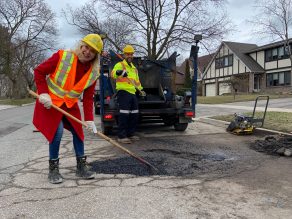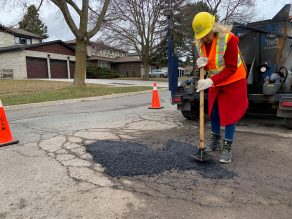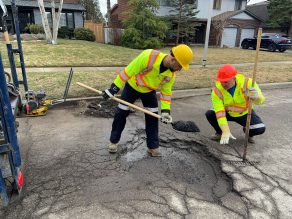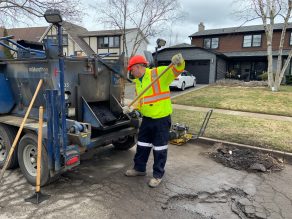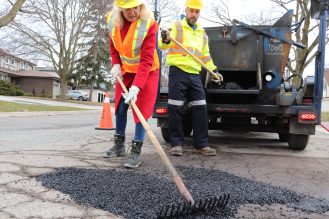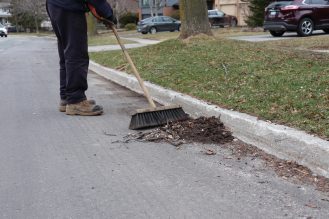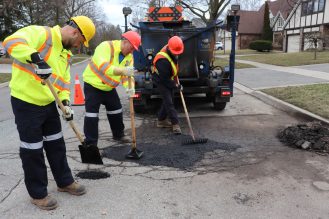Mississauga Is Getting Ready for Spring
City services | March 25, 2022
City roads can become dangerous during winter from snow, ice, extreme cold and periods of milder temperatures. As part of the City’s regular road maintenance, crews routinely monitor road conditions and identify areas needing repairs throughout the year. This includes everyone’s favourite: potholes.
Starting mid-April (weather conditions permitting), the City’s annual spring maintenance and clean-up program will begin.
City crews are taking advantage of the milder weather and are busy filling potholes, performing minor repairs to infrastructure in the roadway, clearing litter and preparing roads and residential areas for street sweeping.
The spring maintenance and clean-up program includes:
- Pothole and roadway damage repair on City roads and on-street bike lanes, including residential streets
- Sidewalk inspection and repair
- Sod damage repair caused by snow clearing
- Litter clean-up on roadways, catch basins and drains
- Street sweeping and hard surface flushing (begins in April) on curb facing sidewalk, traffic islands and hard surfaced boulevards first, followed by roads, curbside gutters and on-street bike lanes
Potholes
Potholes usually occur through the winter as temperatures fluctuate. Weather changes cause water under the asphalt to expand and contract.
In a given year, City crews fix hundreds of potholes with asphalt compacted and smoothed out on roadways. In 2022, there has been a 75 per cent increase in the number of potholes that have been reported in need of repair. Approximately 400 tonnes of asphalt is used for road repair each year.
Repairing potholes is an affordable way to maintain City roads until permanent repairs can be performed. Potholes are usually fixed throughout the spring and each pothole takes roughly 20 minutes to fill. However, crews will repair potholes during the winter months when temperatures are warmer or during emergency situations.
To report potholes and damage to a sidewalk, curb or sod, call 311 (905-615-4311 outside City limits), use the Pingstreet mobile app or submit an online service request.
Street Sweeping
Around mid-April, weather-permitting, the City will begin street sweeping to clear debris left behind from winter. Crews will clean curb-faced sidewalks, traffic islands, hard-surfaced boulevards and curb-side gutters first, then roads and bike lanes.
Street sweeping removes debris, litter and pollutants from entering the City’s stormwater system and eventually making their way into Lake Ontario. The program also improves the cleanliness and aesthetics of City streets and boulevards.
The City’s Works yards continue to store snow-clearing equipment until the end of the winter contract in early April. Remember, when the street sweeping program begins, please remove parked vehicles and avoid raking leaves and grass clippings onto the road.
Parks and Green Spaces
This is also around the time when Parks and Forestry crews are busy getting the City’s green spaces like parks, forests and trails ready to welcome back users. Additionally, they support the maintenance crews by trimming trees, hedges and bushes away from roadways and sidewalks. Contractors will begin performing maintenance operations on recently planted trees, including burlap removal, minor pruning, replacing tree stakes and reforming mulch saucers – this work generally begins at the beginning of March, weather pending.
Construction
While spring cleaning activities happen, residents can also expect the City’s construction season to begin at the end of April. Construction projects include work on roads, bridges, creeks, sewers, watermains and other types of infrastructure. As construction gets underway, residents can use the construction map to plan alternate routes to avoid traffic.
Residents are reminded to please be alert and safe during these periods of spring and construction activity:
- Drive according to road conditions
- Give crews and equipment lots of space to work
- Respect and follow all construction signs and barriers
Annually the City spends upwards of $95.4 million on maintaining, designing and constructing roads. The City’s budget shows that roads make up 9.2 per cent and have steadily increased (by $2.2 million in 2022). As the City continues growing, more people are using roads, sidewalks and bike lanes while the increased demand for more connected infrastructure persists.
Approximately 5,700 kilometres of roads and on-street bike lanes, and 1,700 kilometres of sidewalks are maintained by City crews. This maintenance ensures people can move freely, easily and safely by vehicle, transit, cycling, walking and other modes of getting around. For more information about street and road maintenance, visit mississauga.ca/roads.
Quick facts
- Transportation infrastructure is the largest asset owned and operated by the City of Mississauga with a 2020 replacement value of $5 billion.
- Approximately 400 tonnes of asphalt is used for road repair to help commuters connect to and from Mississauga every day.
- On average, it takes about 20 minutes to fix a pothole.
- Last year, crews responded to 209 service requests for potholes.
- The City has 5,680 kilometres of road network.
- The City’s cycling network includes 601 kilometres of multi-use trails, park paths, bicycle lanes and signed bike routes.
Mayor Crombie’s Video: Mississauga’s 2022 Spring Maintenance
Mississauga’s 2022 Spring Maintenance and Clean-up B-Roll
Photos
Tags
Media Contact:
City of Mississauga Media Relations
media@mississauga.ca
905-615-3200, ext. 5232
TTY: 905-896-5151
